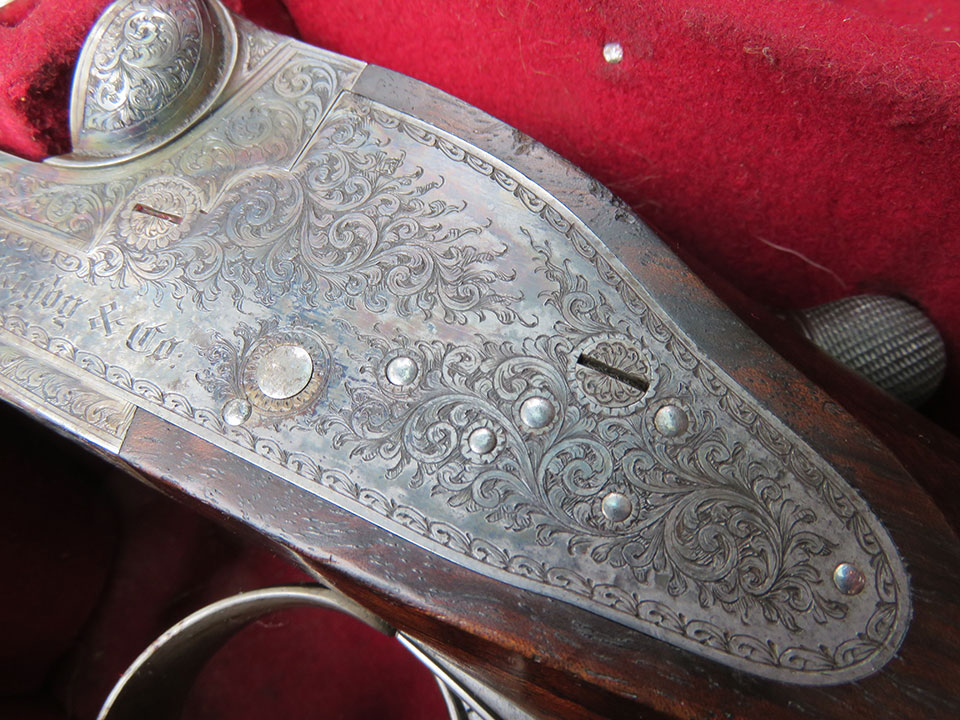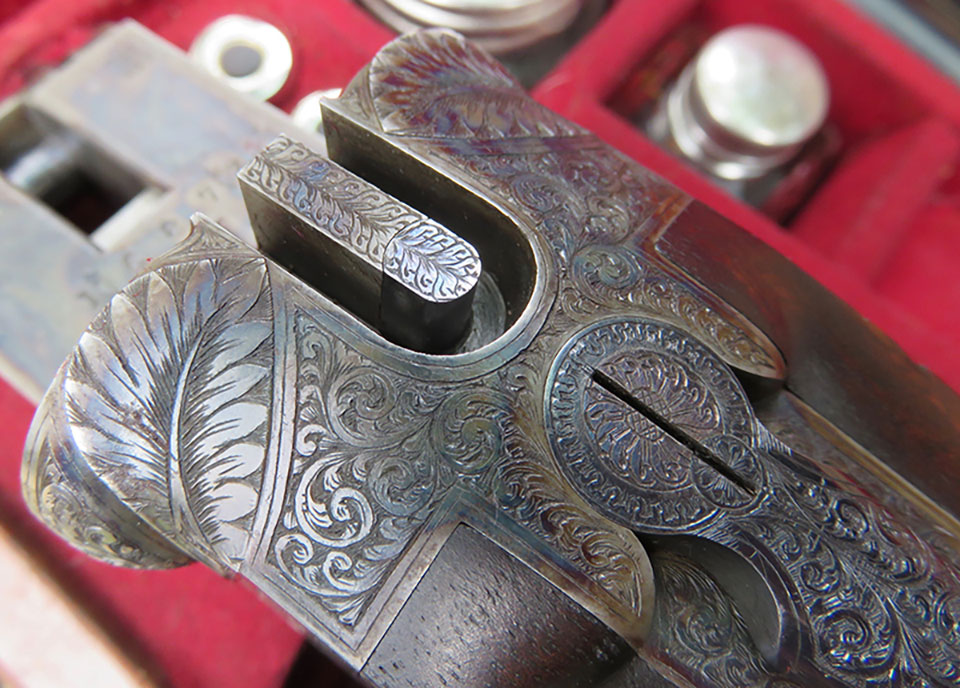Originally a Dublin gunmaker, John Rigby opened his first London premises in 1866. The firm, then in its third generation, had been established in the capitol for thirteen years when John Rigby, grandson of the founder, and Thomas Bissel, a London action-filer and barrel-maker, lodged patent 1141 on 21st March 1879. By doing so, they created what is considered by many aficionados to be the all time classic Rigby action for double guns and rifles.
To put the emergence of the Rigby/Bissell action into context, it was patented 28 years after the Great Exhibition of 1851, at which LeFaucheaux had introduced a fairly effective pin-fire breech-loader onto the British market, which until then was dominated by muzzle loaders. Work to improve security between breech and action had been on-going since that time. Centre-fire, as introduced by Daw in 1861, was still a relative novelty, being in its late teenage years.
Purdey’s 1863 under-bolt patent was a seminal development and it was linked to the, Westley Richards instigated, top-lever by W.M Scott’s ‘spindle’ of 1865. To many this would be seen as arrival at the final destination in development terms but a form of ‘third grip’ was deemed desirable by many gunmakers and necessary by others. Greener’s 1873 ‘Treble Wedge Fast’ action had set the standard.
Rigby & Bissell’s patent listing refers to: ‘Vertical/horizontal bolting for drop-down guns’. It consists of a rising bolt and a rocking lever, worked off the Purdey bolt. The rib extension in the patent , which slots into a recess in the top of the action, has a ‘U’ shaped cut-out into which the rising bolt fits neatly when the gun is closed. The cleverly angled mating surfaces form a subtle hook, rather than a plain vertical plug.
When the gun is opened, by means of a top-lever or under-lever, the vertical top-bolt is pulled down, as the Purdey under-bolt slides back, allowing the barrels to swing downwards on the hinge pin under force of gravity.
One might ask why the same hinging movement cannot occur when the gun is in use. However, when the gun is closed and fired, the bar flexes at the radius, rather than at the hinge pin and the downward trajectory is therefore more acute. The bar attempts to flex on this angle but the rising bolt holds it fast to the top of the action. The tightly-mated bolt and ‘U’ shaped rib-extension bite bolster the lock-up and make the entire action-face hold the gun steady, rather than relying on the bar alone to take the strain.
Heyday
The first firearm Rigby sold which was fitted with the new patent action was delivered on 3rd September 1879 and carried the serial number 15029. Thereafter, Rigby produced both rifles and shotguns built on the Rigby/Bissel patent. Along the way, it became generally referred to as the ‘Rising Bite’, which is technically incorrect, as it is the bolt which rises; the ‘bite’ refers to the female portion of the mating parts and remains demurely passive during coupling. Early Rigby records refer to it correctly as a ‘Vertical Bolt’.

1879, the year the action was patented, was a time in which many gun-making processes were at a crossroads. Traditional damascus barrels were facing the challenge of Whitworth’s new fluid-compressed-steel tubes, Hammerless guns were increasingly popular and would continue to develop into the styles that would dominate the next century. It was a time of daily patent registrations, each hoping to be a step-change in the development of the sporting gun.
The means of propelling the projectile was also in transition. Black powder, then available in many grades and types for specialist applications, was about to give way to the new ‘smokeless’ powders like ‘Schultze’ and ‘E.C’ for shotguns and ‘Cordite’ for rifles. These produced different pressure and combustion characteristics, for which gunmakers would have to adjust.
Into this arena, the Rigby/Bissel action would be thrown but unlike hundreds of contemporary patents which failed, it grew in popularity and acceptance. Rigby made approximately one thousand shotguns and rifles on the action, in calibre’s ranging from
.256 Mannlicher to .450 NE. Varied though the calibre’s and applications may be, the guns share a beauty, a symmetry and a graceful flow of curves, from the lovely dipped-edge lock plates of the classic side lock, to the trademark fluted fences, all perfectly proportioned for each calibre, each subtly different depending on the lock type but always recognisable as a Rigby. They will be encountered bearing Rigby’s address from either London or Dublin.
Notables of the day clearly appreciated the precision, quality and durability of the guns and celebrity clients included maharajahs and colonial big-wigs. They heyday of this trademark Rigby action spanned the years between 1880 and 1910, in which the vast majority of all the examples made were delivered.
Demise
After 1910 the Rigby records show a steady decline in guns built with a vertical bolt action; shogun manufacture was dominated by the Anson & Deeley action, now sourced in the Birmingham trade from the likes of Webley & Scott or Bentley & Playfair, In the second and lower qualities, side-locks were increasingly built without a top fastener, as had become the norm in London.
Following WW1, rifle production also became increasingly based on the Anson & Deeley, typically using the excellent long-table Webley action with the 1884 patent Webley & Brain ‘Screw-Grip’ as a third fastener. The progression of the twentieth century saw increasingly mechanised production, based on standard Birmingham trade models. The plethora of bespoke, individually distinct action types gradually shrunk. By 1930 uniformity had been generally established, with London and provincial firms ordering their basics from Birmingham either as finished guns, or as part-finished guns ‘in the white’ to which they could apply their skills in the final stages.
The Rigby-Bissel action did not lend itself to mass production with machines and it was never adopted as a trade model. A London-trained action filer remarked in a recent conversation; ‘it is one of the most complicated actions to make and one of the most time-consuming”.
It proved uneconomic to apply to lower grades because of the amount of skilled hand-work required to make it properly and, therefore, it was reserved for better quality guns, with higher price tags.
Like Purdey’s spring-cocking side-lock, the Rigby/Bissel was always a ‘house style’, the flagship of the firm which sold it, but it was never adopted by lesser makers for use across a range of qualities. The last Rigby/Bissel rifles to leave the London premises were a pair; the first a .405 Winchester and the other a .350 No.2. They were delivered to the Maharajah of Karauli in 1932. It seemed, thereafter, a classic consigned to history.
Resurrection
Rigby M.D, Marc Newton, is overseeing the new production run of vertical bolt double rifles.
Though ‘retired’ by the trade as a platform for new guns and rifles, as British gun making entered its near-fatal spell in the post-war doldrums; a period marked by mergers, down-sizing and the moth-balling of many, once proud, family firms, the collector and the dabbler in the buoyant secondhand market, and the aficionado, retained a reverence for the classic Rigby action.
One invariably hears murmurs of admiration when observing the cognoscenti examining a fine example. The perfect mating of the bolt into the bite, the beautiful blending of an apparently complex and multi-part mechanism into an aesthetically pleasing, totally balanced and perfectly functioning firearm never fails to create a frisson of excitement. Those who know it appreciate it, those seeing one for the first time marvel at the perfection of form and function.
It has been lamented down the years that nobody can make these anymore; they are too difficult, too expensive, they had their day in the black-powder rifle era, they are unsuited to modern calibre’s and modern demands. There have even been attempts to revive the ‘rising-bite’ by foreign manufacturers but they have been crude imitations of the original masterpieces..
To the informed observer, it appeared as if the action had been laid to rest, never to return in its true form in rifles of real quality. However, the Rigby/Bissel action is on the cusp of a spectacular resurrection and the firm responsible is Rigby itself. Having spent years in the wilderness under American ownership, Rigby has returned to London with new premises, just south of the Thames, an ambitious and able new M.D in Marc Newton, who inherited his Rigby credentials through years working alongside the old master Paul Roberts, and new financial muscle provided by Blaser.
Amidst all this novelty, the company has taken a look into its past glories for inspiration and is once again producing the two sporting rifles for which it was once renowned: the Rigby/Mauser bolt-action and the Rigby/Bissel double rifle.
For a template, the Rigby team, under Head of Production, Ed Workman, whose experience at top London firms, building best guns is unrivalled, disassembled and reverse engineered a 1902 double rifle, made for the Maharajah of Udaipur. This has been replicated and scaled to house the popular big game calibres of the moment: the .470 and the .500 Nitro Express. With twenty one rifles in production, many already ear-marked by existing clients, Rigby looks poised to re-enter the big league as suppliers of serious double rifles to the most discerning hunters and collectors. Delivery time from order is approximately three years, which is not unreasonable, and the price tag, if you need to ask, is a hefty £95,000 in basic scroll-engraved form.
Precision engineering meets bespoke gun-making. The Rigby team are blending state of the art technology with old-school craftsmanship.
However, there is nothing ‘basic’ about these rifles. Perfect in fit and finish and constructed in the very best modern steels by the finest gun makers working today, these are hand made double rifles of the highest order. 13-19 Pensbury Place, London has become one of the ‘must visit’ destinations for the firearm aficionado and looks set to grace the ribs of best sporting rifles well into the future.
African hunters will, once again, be preparing for safari with a proper Rigby, made to order and made in the 21st century by a firm standing on solid ground with an air of confidence few in the world can match.
Published by Vintage Guns Ltd on (modified )




